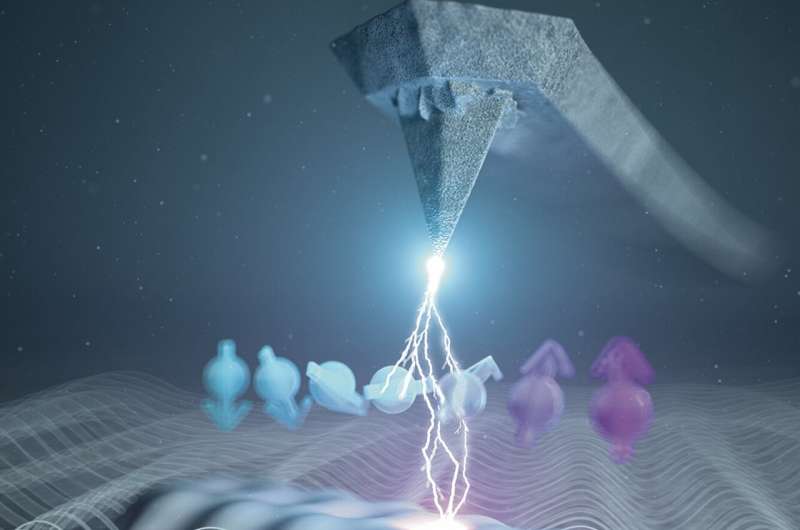This article has been reviewed according to Science X's editorial process and policies. Editors have highlighted the following attributes while ensuring the content's credibility:
fact-checked
peer-reviewed publication
trusted source
proofread
A novel microscope operates on the quantum state of single electrons

Physicists at the University of Regensburg have found a way to manipulate the quantum state of individual electrons using a microscope with atomic resolution. The results of the study have now been published in the journal Nature.
We, and everything around us, consist of molecules. The molecules are so tiny that even a speck of dust contains countless numbers of them. It is now routinely possible to precisely image such molecules with an atomic force microscope, which works quite differently from an optical microscope: it is based on sensing tiny forces between a tip and the molecule under study.
Using this type of microscope, one can even image the internal structure of a molecule. Although one can watch the molecule this way, this does not imply knowing all its different properties. For instance, it is already very hard to determine which kind of atoms the molecule consists of.
Luckily, there are other tools around that can determine the composition of molecules. One of them is electron spin resonance, which is based on similar principles to an MRI scanner in medicine. In electron spin resonance, one usually needs, however, countless molecules to obtain a signal that is large enough to be detectable. With this approach, one cannot access the properties of every molecule, but only their average.
Researchers at the University of Regensburg, led by Prof. Dr. Jascha Repp from the Institute of Experimental and Applied Physics at the UR, have now integrated electron spin resonance into atomic force microscopy.
Importantly, the electron spin resonance is detected directly with the microscope's tip, such that the signal comes from one individual molecule only. This way, they can characterize single molecules in a one-by-one fashion. This allows one to determine of which atoms the molecule they just imaged is composed.
"We could even discriminate molecules that do not differ in the type of atoms that they were composed of, but only in their isotopes, namely, in the composition of the atoms' nuclei," adds Lisanne Sellies, the first author of this study.
"Yet, we are even more intrigued by another possibility that electron spin resonance entails. This technique can be used to operate the spin-quantum state of the electrons present in the molecule," says Prof. Dr. Repp.
Quantum computers store and process information that is encoded in a quantum state. To perform a calculation, quantum computers are required to manipulate a quantum state without losing the information by so-called decoherence. The researchers in Regensburg showed that with their new technique, they could operate the quantum state of the spin in a single molecule many times before the state decohered.
Since the microscopy technique allows the image of the individual neighborhood of the molecule, the newly developed technique could help understand how decoherence in a quantum computer depends on the atomic-scale environment and—eventually—how to avoid it.
More information: Lisanne Sellies, Raffael Spachtholz, Sonja Bleher, Jakob Eckrich, Philipp Scheuerer, Jascha Repp, Single-molecule electron spin resonance by means of atomic force microscopy, Nature (2023). DOI: 10.1038/s41586-023-06754-6
Journal information: Nature
Provided by University of Regensburg





















